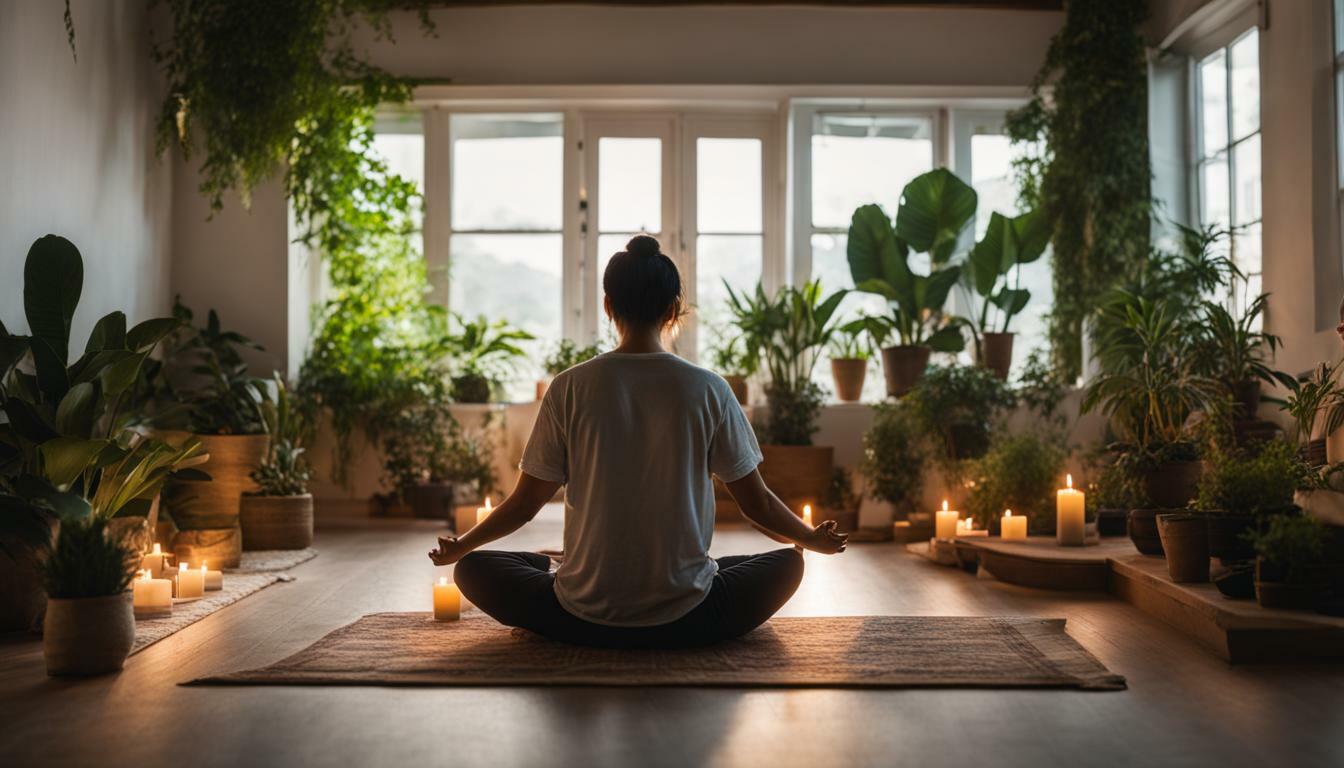Sitting in the right meditation position is crucial for a fruitful mindfulness practice. Whether you’re a seasoned meditator or just starting out, mastering the art of sitting in a meditation position can greatly enhance your journey toward inner peace. In this article, we will explore different meditation postures and provide step-by-step instructions on achieving proper alignment. So, let’s dive in and discover the key to sitting comfortably and mindfully.
Key Takeaways:
- Choose a comfortable meditation posture that allows for proper alignment of your hips, knees, and back.
- Explore sitting cross-legged, standing, kneeling, or lying down as alternative meditation positions.
- Consider using cushions for support when kneeling or maintaining mindfulness while lying down.
- Try the seven-point meditation posture to ensure proper alignment of your spine, hands, shoulders, chin, jaw, and gaze.
- Standing meditation can be a great option for those who find sitting uncomfortable or have physical limitations.
Finding a Comfortable Posture for Meditation
There are various options for sitting in meditation, but the key is to find a comfortable posture that promotes relaxation and focus. When sitting, it is important to maintain a straight back and relaxed shoulders. You can try sitting cross-legged with your hips slightly higher than your knees, ensuring proper alignment of your spine. This posture allows for a stable and grounded position, helping you to stay focused during your meditation practice.
If sitting cross-legged is uncomfortable, you can explore other options like kneeling or lying down. Kneeling can be supported by using cushions to elevate your hips and reduce strain on your knees. It is important to find a position that allows you to maintain proper alignment of your spine and relax your shoulders. Lying down, on the other hand, is a great option for relaxation, but be mindful of not falling asleep. Find a comfortable surface and make sure to support your head and neck with a pillow if needed.
Seven-Point Meditation Posture
Another technique you can try is the seven-point meditation posture. This involves checking the alignment of your spine, hands, shoulders, chin, jaw, and gaze. Start by sitting on a cushion or mat with your legs crossed and your hips slightly higher than your knees. Keep your back straight and relaxed, allowing your spine to naturally align. Place your hands on your lap, palms facing upwards. Gently tuck in your chin, relaxed your jaw, and lower your gaze towards the floor. This posture helps to create a sense of stability and ease, allowing for a deeper meditation experience.
Remember, the goal is to find a meditation posture that allows you to be comfortable and focused. Experiment with different positions and see what works best for you. The right posture can make a significant difference in your mindfulness practice, helping you to cultivate a deeper sense of peace and presence.
| Sitting Position | Description |
|---|---|
| Cross-legged | Sit with your legs crossed, ensuring your hips are slightly higher than your knees. Maintain a straight back and relaxed shoulders. |
| Kneeling | Kneel on a cushion or mat, using support for your knees if necessary. Align your spine and relax your shoulders. |
| Lying down | Find a comfortable surface and lie down, supporting your head and neck if needed. Be mindful of not falling asleep. |
Whichever posture you choose, the most important thing is to find a position that allows you to be present and at ease. Your meditation practice is a journey, and finding a comfortable posture is an integral part of that journey. So take some time to explore different options, listen to your body, and discover the posture that supports your mindfulness and inner peace.
Mastering the Seven-Point Meditation Posture
The seven-point meditation posture is a powerful technique to enhance your meditation experience by ensuring proper alignment and focus. When you sit down for meditation, it is important to find a comfortable position that supports your body while allowing you to remain alert and present. Let’s explore the seven points of this posture and how they can benefit your practice:
- Spine: Begin by aligning your spine in a natural, upright position. Imagine a string gently pulling the crown of your head towards the sky, creating length and space in your spine.
- Hands: Rest your hands on your lap, palms facing upwards or downwards, whichever feels more comfortable for you. This allows for ease and relaxation in your upper body.
- Shoulders: Relax your shoulders and let them naturally fall away from your ears. This helps release tension and promotes a sense of openness.
- Chin: Gently tuck your chin in towards your chest, creating a slight lengthening in the back of your neck. Be mindful not to strain or force the movement.
- Jaw: Soften your jaw and allow your teeth to separate slightly. This helps release tension in the face and promotes a sense of ease.
- Gaze: Set your gaze softly downwards, about three to four feet in front of you. This allows for a more focused and introspective state of mind.
Proper Alignment for a Comfortable Meditation Seat
Now that you know the seven points of the meditation posture, it’s important to find a comfortable seat that supports your body. Sit on a cushion or meditation bench, ensuring that your hips are slightly higher than your knees. This helps to maintain the natural curve of your spine and provides stability during meditation.
| Seat Option | Benefits |
|---|---|
| Cross-Legged | Provides a stable base and promotes a sense of groundedness. |
| Kneeling with Cushions | Offers support for those who find sitting cross-legged uncomfortable. Maintains alignment and stability. |
| Lying Down | Allows for deep relaxation, but be mindful of not falling asleep. Use a yoga mat or cushion for comfort. |
Remember, your posture during meditation sets the intention for your practice. Find a position that allows you to focus and relax without constant readjustment. Explore different options and listen to your body’s needs. With practice and patience, you will discover the posture that best supports your meditation journey.
Exploring Alternatives: Kneeling and Lying Down
If sitting cross-legged is uncomfortable, you can try kneeling with cushions or lying down for a different meditation experience. Kneeling provides a more grounded posture and helps to alleviate pressure on the knees and ankles. It is important to use cushions or a meditation bench to support your knees and sit comfortably. This position allows for a deeper connection with the earth and promotes a sense of stability during meditation.
Lying down is another option that can be particularly beneficial for relaxation and body awareness. This position allows for complete support and relaxation of the body, making it ideal for individuals with physical limitations or discomfort. However, it is important to be mindful of not falling asleep during your practice. To maintain attentiveness, you can place a small cushion or rolled-up blanket under your neck for added support and to prevent drowsiness.
Both kneeling and lying down offer unique benefits and can enhance your meditation practice. By exploring these alternatives, you can find a comfortable meditation seat that suits your body and allows for a deeper sense of relaxation and focus. Remember, your posture during meditation sets the intention for your practice, so find a position that allows you to be present and attentive without constant readjustment.
Table: Comparing Kneeling and Lying Down Meditation Positions
| Position | Benefits | Considerations |
|---|---|---|
| Kneeling | Grounded posture, stability, reduced knee and ankle pressure | May require cushions or a meditation bench for support |
| Lying Down | Complete body support, ideal for relaxation and body awareness | Increased risk of falling asleep, use support under the neck to stay attentive |
Remember, the goal is to find a meditation posture that allows you to focus and relax. Take the time to experiment with different positions and determine what works best for you. Whether you choose to sit cross-legged, kneel, or lie down, the key is to find a comfortable meditation seat that supports your practice and enhances your mindfulness journey.
Standing Meditation for Comfort and Focus
Standing meditation offers a unique approach to mindfulness practice for those who prefer not to sit or have difficulty doing so. It provides an opportunity to cultivate presence and awareness while standing still, allowing you to connect with your body and surroundings in a different way. Whether you have physical limitations or simply find sitting uncomfortable, standing meditation can be a valuable addition to your mindfulness routine.
In order to practice standing meditation effectively, start by finding a stable and comfortable position. Stand with your feet hip-width apart and rooted firmly into the ground. Keep your knees slightly bent to maintain balance and stability. Relax your legs and pay attention to any tension or discomfort. Gradually adjust your stance until you find a position that feels natural and steady.
As you stand, bring your attention to your breath. Allow it to flow naturally and observe the sensation of each inhalation and exhalation. Notice any sensations in your body, such as the feeling of your feet on the ground or the movement of your chest as you breathe. Stay present and fully engaged in the experience of standing, letting go of any distractions or thoughts that arise.
To minimize distractions during standing meditation, you can clasp your hands together in front of your lower abdomen. This helps to keep your arms relaxed and prevents them from swinging or moving unintentionally. By keeping your hands clasped, you also create a physical reminder to stay present and focused.
| Benefits of Standing Meditation | Guidelines for Standing Meditation |
|---|---|
|
|
Standing meditation can be a valuable alternative for individuals who struggle with traditional seated meditation positions. It allows you to maintain a sense of grounding, stability, and focus while engaging your body in a different way. Experiment with standing meditation and see how it can complement and enhance your mindfulness practice.
Conclusion
Your meditation posture sets the intention for your practice, so take the time to discover the position that brings you tranquility and peace. Mastering the art of sitting in a meditation position can greatly enhance your mindfulness practice. While most people are familiar with sitting cross-legged, there are other options such as standing, kneeling, or lying down.
When sitting, it is important to find a comfortable posture with your hips slightly higher than your knees. Maintain a straight back and relaxed shoulders. You can also try the seven-point meditation posture, which involves checking proper alignment of the spine, hands, shoulders, chin, jaw, and gaze.
If sitting is uncomfortable, you can kneel with cushions for support. Lying down is an option for relaxation, but be mindful of not falling asleep. Finally, standing meditation is a great alternative for those who find sitting uncomfortable or have physical limitations. Find a stable position with relaxed legs and back, and keep the arms and hands clasped to minimize distractions.
Your meditation posture sets the intention for your practice, so take the time to discover the position that brings you tranquility and peace. Experiment with different postures and find what works best for you. With consistent practice, you’ll be able to sit comfortably in a meditation position that allows you to focus and relax without constant readjustment. Embrace the journey towards inner peace and harness the power of mindfulness through the art of sitting in a meditation position.
Can Opening the Third Eye Help with Achieving a Comfortable Meditation Position?
Opening your third eye meditation can indeed help with achieving a comfortable meditation position. By activating this mystical energy center in our minds, we enhance our concentration and awareness, allowing us to find a more relaxed and focused state. When our third eye is open, it becomes easier to clear our minds, release tension, and assume a comfortable posture during meditation.
FAQ
What are the different sitting options for meditation?
The different sitting options for meditation include cross-legged, standing, kneeling, and lying down.
How should I find a comfortable posture for meditation?
To find a comfortable posture for meditation, ensure that your hips are slightly higher than your knees, maintain a straight back, and relax your shoulders.
What is the seven-point meditation posture?
The seven-point meditation posture involves checking the proper alignment of the spine, hands, shoulders, chin, jaw, and gaze for a more effective meditation practice.
How can I comfortably kneel for meditation?
To comfortably kneel for meditation, you can use cushions for support and maintain mindfulness throughout the practice.
Can I lie down for meditation?
Yes, lying down is an option for relaxation during meditation. However, be mindful of not falling asleep and maintain awareness throughout the practice.
How can I practice standing meditation?
To practice standing meditation, find a stable position with relaxed legs and back, and clasp your arms and hands to minimize distractions.








